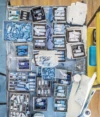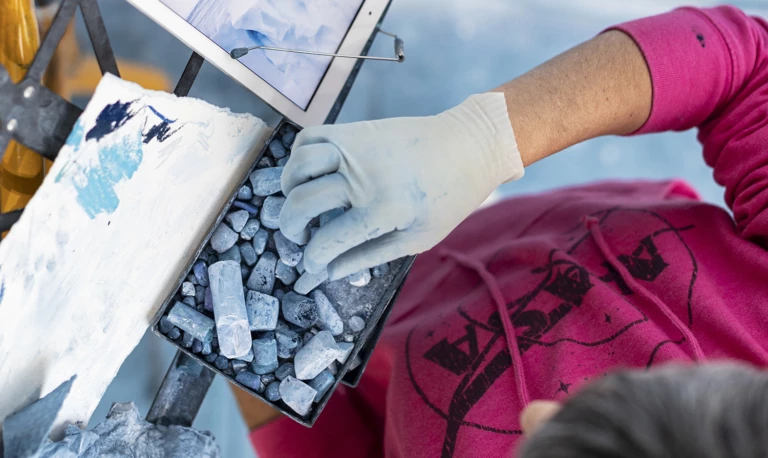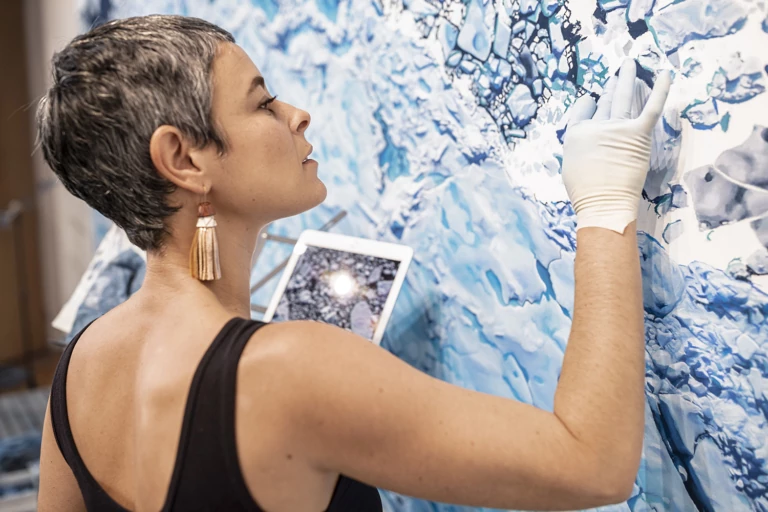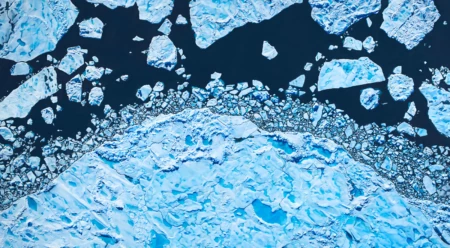The Art of Loss: How Zaria Forman Draws Stunningly Realistic Polar Ice
It’s fascinating to hear Zaria Forman talk about ice, especially the way that it sounds. She describes the way it rumbles and thunders and cracks, even when you can’t see anything. It crackles and pops like breakfast cereal on high volume. “Ice crispies,” she calls it. “It’s a really beautiful sound.”
Polar ice is possibly the most obvious and yet also the most abstract visual metaphor for the climate crisis. Images of calving glaciers, floating icebergs and receding ice sheets have become a sensory shorthand for the increasing vulnerability of a warming world. They’re familiar yet remote—an emotionally distant force that often fails to transcend human behavior.
That is where art is essential.
Forman has been drawing large-scale, nearly photo-realistic images of water in all its forms for over a decade, but glacial ice is her most recognizable subject. “From an artistic perspective, it’s an endless source of inspiration,” she says. “There are so many surfaces and textures.” But for her, the work is more than symbolic. She’s been up close to these massive ice sheets, spending time with climate scientists to understand how ice is being affected and its impacts on the wider world in order to transfer the objective to the emotional.

Forman uses soft pastels to detail the forms of water and ice. Photo: Tim Davis
Forman’s studio in Brooklyn, New York, is coated in a fine layer of blue powder—a mixture of pigments from her pastel tray that sticks to surfaces and the soles of shoes, and turns white rubber to the color of a muted Otter Pop. She uses pastels because of the physicality of the medium. “There isn’t a lot of room for error. I draw on a very smooth paper, which is not what most pastel artists would want,” she says. “It doesn’t absorb a lot of pigment.” She uses different pads of her fingers to draw different features of ice and water. Her thumb is to smudge and tint; the middle finger is more precise for finer detail. She draws at eye level. “Whites are the hardest to work with,” she says.

Forman getting the details right. Photo: Tim Davis
Her hair is cropped short and streaked with silver, and she discusses everything from planetary destruction to Acroyoga with a tone of hopeful enthusiasm. She’s dressed in a pink NASA sweatshirt and black jeans. “I love hot pink, which is funny because everything I draw is blue,” she says.
Across the room, three drawings the size of area rugs hang in various states of completion. The largest is from NASA’s Operation IceBridge, a decade-long, airborne science mission to map the ice at both poles. Forman was invited to join them on the plane after the lead navigator came across her work. He grew up in a family of artists and told her in the invitation that he understood the importance of communicating data in a way that antiseptic numbers can’t.

This area in the Lincoln Sea usually has some of the oldest and thickest ice in the Arctic. NASA’s IceBridge team measures it to study long-term changes in the thickness of the ice. Typically, the ice gets pushed up against the coast by the ocean circulation and creates large pressure ridges. The bright-blue melt ponds on the surface appear in the summer. Rough ice creates a trap for melt ponds to form, so usually the melt ponds are deeper (a few feet at most) in this area of the Arctic because of the topography. Photo: Tim Davis
She stayed with them for three weeks, flying over Antarctica every day that the weather allowed, while the researchers measured the geography of the ice. “I was used to seeing the faces of glaciers or icebergs floating in the water, which is kind of the end result before it melts,” she says. “So getting to see the ice sheets and how they start to grow and crack under their own weight and move into glaciers and move toward the water? That was just incredibly eye-opening.”
In a TED Talk Forman gave in 2015, she mentions a theory in behavioral psychology that says emotions, more than anything else, move us to action. We can hear over and over about parts per million and feet of sea level rise, but unless we feel, we won’t act. Art can get us to do something. That, at least, is Forman’s vision. It forces us to slow down, to find personality and soul in the abstract, and to really notice what’s going on. Climate change is enormous and sometimes far away; rendering it as art brings everything a little closer to home.
This essay was featured in the 2019 Patagonia November Catalog.

